PinotFile: 7.22 August 5, 2009
|
Papa Pinot’s Legacy Pervades 2009 IPNC
“David Lett defined the term “visionary,” sailing against a strong current as he fulfilled the
promise of Oregon wine. He planted grapes where others deemed it impossible, understanding
that the very finest wines are often grown where it is most perilous, and he thrived on that
challenge. His personality set the tone for the character of the Oregon wine industry, and his
stunning wines rewarded his fearlessness, focus and independence. For those who prefer their
opinions strong and their wines elegant, David was your man. What an inspiration.”
Ted Farthing, Oregon Wine Board Executive Director
Each July for the past twenty-four years, McMinnville, Oregon, has become Beaune in the USA. 700 Pinot geeks from all over the country and from every corner of the world descend on this inauspicious town to celebrate the fickle darling of wine cognoscenti and revel in their indulgence. The International Pinot Noir Celebration (IPNC) is held on the intimate and bucolic campus of Linfield College, but there is no homework or written tests, and no dreadful lectures at 8:00 in the morning, just an abundance of great Pinot Noir paired with the delicious bounty of Oregon prepared by the Pacific Northwest’s most talented chefs, and plenty of joie de vivre. This year’s IPNC, held on July 24-26, 2009, marked the twenty-third event, dating back to 1987, when a group of grape farmers and winemakers assembled to figure out a way to promote Oregon wine. One of the important contributors to that group was David Russell Lett, a seminal figure in the history of Oregon wine. David was but one of several Oregon wine pioneers who emigrated to Oregon from elsewhere, but he is remembered as the first to successfully plant and vinify Pinot Noir and Pinot Gris in the Willamette Valley of Oregon. He was steadfast in his determination to create light, supple and ephemeral wines that aged, and nearly every Oregonian has drank an Eyrie wine at some point in their lives that was an epiphany. He was so revered that in his later years he become affectionately known as “Papa Pinot." Lett passed away in October 2008 at the age of 69, but his memory was pervasive at this year’s IPNC, and every meal was launched with an emotional toast to this beloved man. Lett was the son of am insurance agent and had grown up in Utah. His grandfather was a doctor, and Lett, being the first male progeny in the family, was urged to obtain a medical degree. Instead, he found himself in the Napa Valley in 1962 following an interview for professional school in the San Francisco Bay area. He quickly became enthralled with winegrowing, and to his parent’s dismay, decided to pursue a degree in viticulture and enology at University California Davis. The 1960s were a time when the thrust of the California wine industry was Cabernet Sauvignon and Chardonnay, but Lett was consumed by Pinot Noir. At Davis, Lett’s Professor, Harold Berg, told him that there were very few climates suitable for Pinot Noir in the United States, but Lett was not easily deterred. He considered New Zealand and even Portugal, but kept coming back to Oregon, thinking it was the closest climate to Burgundy. Lett's schoolmate at Davis was Charles Coury who had a degree from University California Los Angeles in climatology and understood growing seasons. After graduating from Davis, Coury spent a year at the Alsace Wine Research Station in France which had a climate very similar to Oregon’s. When he returned, Coury was convinced that Pinot Noir would ripen in Oregon, and he headed north to Oregon in 1965, the same year that Lett, who preceded him by a few months, emigrated to Oregon.
According to Kerry McDaniel Doenisch in Vineyard Memoirs, Oregon Wine Pioneer Recollections of Living, Grape-Growing and Winemaking in the 1970s, Charles Coury came to Oregon with his father and purchased 45 acres with an abandoned vineyard on Rueter Hill near Forest Grove in 1965. Together with his wife Shirley and sister-in-law, Betts Coury, they operated a winery, vineyard and nursery until 1978. The Courys planted 25 acres of Pinot Noir, Chardonnay, Gewürztraminer and Riesling and produced wines from each of these varieties. The Coury Winery was eventually sold and became Laurel Ridge Winery. Currently, the site is the David Hill Vineyard & Winery. Betts Coury said about Charles Coury, “He was ahead of his time. He had all the right ideas about how to start a winery in Oregon - and proved it could be done.” Coury was quoted as telling Betts, “The reason I moved to Oregon in 1965 was to prove that excellent Burgundian and Alsatian wine grapes could be grown there. California certainly wasn't producing any decent Pinot Noir. For that matter, no one at the time in any part of the United States could really produce a decent Pinot.......but I could, so I did.” Coury proclaimed he was the second person to make a decent wine in Oregon, the first being Richard Sommers of Hillcrest Winery in Roseburg (Rogue Valley), who planted Pinot Noir and other varieties between 1957 and 1961. Coury said, “Sommers is the original pioneer, not me. I was the second. Before Lett, before Fuller, before Erath. I graduated way ahead of those guys. Heck, they all read my thesis at Davis on cold-climate growing and argued with me about whether it could be done successfully in Oregon.” Coury said he had long debates with fellow students Lett and Fuller and, “I guess my opinions must have been persuasive, because a few years later they all showed up in Oregon.” Betts claimed, “Lett was converted to the idea of growing grapes in Oregon when he went to visit Coury in Alsace.” According to Jason Lett, David Lett disputed Coury's claims and was firmly convinced that in 1966 he was the first to plant Pinot Noir in the Willamette Valley although accurate records make it difficult to verify this. It is well documented that David Lett was the first to plant Pinot Gris in Oregon. Coury brought back root stock from Alsace and Burgundy and shipped cuttings to the agricultural quarantine port in San Francisco. One of the Pinot Noir selections (it is impossible to verify its exact origins) became known as the Coury clone now designated Pommard UCD 4. (More on the history of Oregon Pinot Noir clones on page 7).
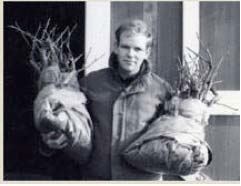 Lett gathered up 3,000 vine cuttings including the Wädenswil clone of Pinot Noir (UCD 1A/2A) from University California Davis, loaded them into the bed of his uncle’s horse trailer, and headed to Oregon at the tender age of 25 years. He rooted the vines in a field near Corvallis while he searched the Northern Willamette Valley for a suitable site for his vineyard. Coury and Lett were roommates in Corvallis while each worked for separate nurseries in the area. Lett was the first to plant Pinot Noir and Pinot Gris there. Lett bought 20 acres in the Dundee Hills for $450 an acre and in 1966, spent his honeymoon with his new spouse Diana planting the first five acres of vines of Pinot Noir, Chardonnay, Pinot Gris, Riesling, Gewürztraminer, Muscat Ottonel and Pinot Meunier. It has been rumored that Lett planted some suitcase clones from the Domaine de la Romanée-Conti (possibly sourced from Coury) along side the Wädenswil clones of Pinot Noir, but David Lett's son, Jason, discounts the accuracy of this rumor. Although the climate was similar to Burgundy, the plantings were not. Instead of limestone soil, the vineyard was composed of volcanic clay loam soil (now known as Jory soil). The vines were widely spaced (6’ x 10’) and trained high according to the California mold of the time. The Letts named their vineyard Eyrie (“eye-ree”), after a hawk nest nearby. Lett produced his first Pinot Noir in 1970, but because of its light color, he labeled it “Oregon Spring Wine,” and sold it for $2.65 a bottle. In 1979, Robert Drouhin of the famed Domaine Drouhin in Burgundy, set up a blind tasting of French burgundies versus American Pinot Noirs. At this now famous tasting hosted by the French food and wine magazine Gault-Mileu and held in Paris, a 1959 Domaine Drouhin Chambolle-Musigny came in first, but David Lett’s 1975 Eyrie Vineyards South Block Reserve Pinot Noir took second ahead of 1961 Domaine Drouhin Chambertin-Clos de Béze. The Eyrie wine was made solely from the Wädenswil clone UCD 1A. This was a seminal event for winegrowing in Oregon and persuaded Robert Drouhin to establish his own vineyard and winery in the Dundee Hills in 1987. According to John Winthrop Haeger (Pacific Pinot Noir), there is a total of 6.5 acres of Pinot Noir in Lett’s original vineyard of 20 acres. The vines are 70% own-rooted UCD 1A (from the same mother vines as UCD 2A) and Pommard 5, and 30% own-rooted UCD 18. A second vineyard, Stonehedge is adjacent and planted in 1979 and 1980. There are 2 acres of UCD 1A/2A and Pommard 5 Pinot Noir out of a total of 15 acres. Two other vineyards were planted in the late 1980s, Rolling Green Farm and Three Sisters, both UCD 2A and Pommard 5 (total of 9.1 acres between the two vineyards). Lett fashioned his Old World style wines in a former turkey processing plant in McMinnville. The winery was inauspicious but Lett never believed in pretentiousness and he frowned on tasting rooms. His wines were often light in color and body, unappealing in their youth, yet were remarkably age-worthy. Lett never wavered from his vision of how wine should be fashioned and never tried to please everyone. He was a firm advocate of preserving the delicacy and nuances of Pinot Noir. He weathered many challenging vintages in Oregon, in some years relying on purchased grapes when his estate vineyard faltered. It is unknown to many that during the 1970s, Lett needed more grapes as his vines matured and the popularity of Eyrie wines increased, so he purchased Cabernet Sauvignon, Merlot and Sauvignon Blanc grapes from Washington. Reportedly, his Cabernets were impressive, although he professed to dislike the grape. Before David Lett passed away, he handed the winemaking reigns at Eyrie to his son, Jason, who took over with the 2005 vintage. Jason spent time at Maison Joseph Drouhin in Burgundy and has a degree in plant ecology from University of New Mexico. He is committed to continuing the Eyrie style (he fashions a more “New World” gutsy Pinot Noir under his Black Cap label). A historic tasting of every reserve Pinot Noir made at Eyrie was held the day before the 2008 IPNC and this was an official retirement party for Lett. The details of this tasting were posted by Michael Alberty of the Story Teller Wine Company in Portland (http://www.storytellerwine.com/wine/wp-content/plugins/st_newsletter/ stnl_iframe.php?newsletter=107). Some of the Pinot Noirs from the 1970s were remarkably preserved. The day before this year’s IPNC (July 23, 2009), I was fortunate to be invited to a retrospective tasting of every vintage of The Eyrie Vineyards Chardonnay from the first vintage in 1970 to the current 2007 release. This event was hosted by Jason Lett and Emily Stoller Smith and held at The Eyrie Vineyards winery in McMinnville. This was the most remarkable Chardonnay tasting I had ever attended and the general tone of those in attendance, which included Jancis Robinson, was one of heightened admiration for the wines. The first Eyrie Reserve Chardonnay was released in 1987 so many vintages after this were Reserve bottlings. In some vintages, such as 1982, 1983 and 1984, fruit was purchased to supplement the Eyrie fruit.
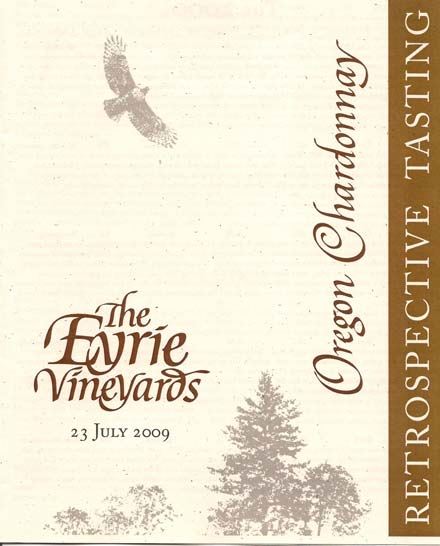 Before the retrospective tasting event, Jason Lett tasted through 1,841 bottles of Eyrie Chardonnay, one vintage at a time, to find pristine bottles which were then blended and put into new bottles under neutral gas. He found a 3-5% incidence of cork taint (some older vintages had more), and an average 30% rate of oxidation (a few vintages had a significant amount with 1986, for example, showing a 56% oxidation rate, and 2000 an 80% oxidation rate). The problems with corkage and oxidation led Jason to bottle all Eyrie Chardonnay under Diam closure beginning with the 2008 vintage. The Chardonnay vines at Eyrie are known as the Draper selection. In late 1964, David Lett sought out cuttings from Joe Torres, the long time vineyard manager for the Draper Ranch in St. Helena. In the process of managing the Ranch, Torres had selected certain blocks and vines which were his favorites. Some of the fruit from these selected vines went to Souverain Cellars on Howell Mountain where Lee Stewart made some legendary Chardonnays from these grapes. Jerry Draper, Lee Stewart and Fred McCrea (Stony Hill) all planted their vineyards on the hillsides of Napa Valley in 1943. The original source for much of their Chardonnay cuttings came from Louis Martini’s Stanley Ranch in Carneros, which was planted with a diversity of European vines in the mid-1930s. The cuttings Lett took from the Draper Ranch and Torres’ selection became the basic vines of The Eyrie Vineyards. Lett made two Chardonnays entirely with clone 108 - 1978 and 1980, but subsequent wines were predominantly Draper clone. In 1967, University California Davis isolated a clone of Chardonnay known as 108 and decided it was the best Chardonnay clone for California conditions. High yields and low acid were foremost in this decision. Almost every vineyard planted to Chardonnay in California since 1967 was planted to clone 108. As wine became more popular, clone 108 spread to other states, but regrettably, the wines were often alike and somewhat boring. The Draper Chardonnay selection includes a diversity of clones and the resultant wines made with this selection at Eyrie produced wines that were more elegant and more subtle in expression. The Eyrie Chardonnay winemaking regimen is as follows. The grapes are de-stemmed, crushed and pressed gently. The juice is settled overnight to separate it from the heavy solids which can lead to off flavors in the final wine. The juice is then transferred to seasoned French oak barrels where it is inoculated with a variety of pure yeast strains. Cellar temperatures are naturally low in Oregon in October when the grapes are harvested so no temperature control is required. The wines ferment at their own pace and go through a complete, spontaneous (not induced) malolactic fermentation (MLF) through the winter and spring (since 1977). The barrels are topped frequently and the wine rests undisturbed sur-lie until time for bottling eleven months after crush. The wine is not fined for protein stability nor is it tartrate stabilized (until 2004). The wine is moderately filtered and then bottled. Total annual production varied from 99 (1970) to 1,249 (1986) cases.
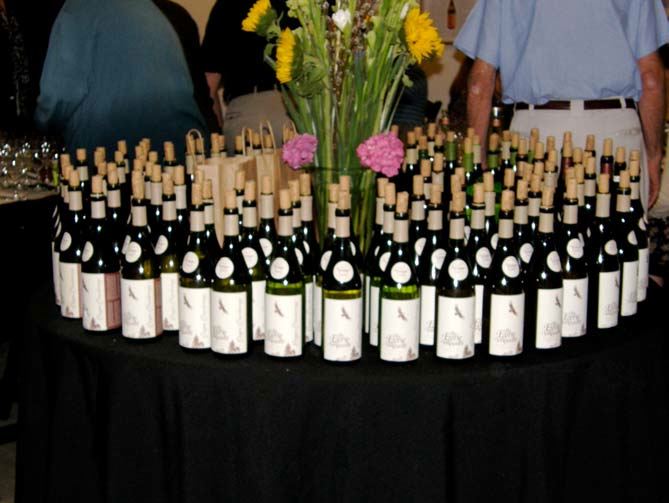 I will spare you my tasting notes on all 38 Eyrie Chardonnays tasted, but a few general comments may be of value. Nearly all the wines were remarkably fresh, with vivid acidity and retention of a light yellow color. The wines exhibited restraint with subtle, layered and lean yellow fruit flavors, minerality, and vanilla wafer notes. For the most part, the wines had excellent fruit and acid balance and would match well with and enhance food. 2000s: Jason Lett made the 2005 (the 2005 Black Cap Chardonnay was tasted as the Eyrie Chardonnay did not meet expectations), 2006 and 2007 vintages. Decade Brix range was 21º-22.8º, acidity range was 3.36-3.62. Dominant aromas were lemon, tropical fruits, white stone fruits, roasted nuts, and flowers. Notable flavors included lemon zest, pineapple, tropical fruits, pear and brioche with bright acidity on most wines. My favorites in order were the 2002 Reserve, 2001 Reserve and 2000 Reserve. The group favorites were the 2002 Reserve followed by the 2004 Estate. 1990s: Decade Brix range was 19.2º-22.4º, acidity range was 3.38-3.70. Dominant aromas were lemon, melon, nuts, baking spice, petrol and veggies. Notable flavors included green apple, pear, seasoned wood, cooked banana, lemon tart, seasoned wood and brioche. My favorites in order were the 1992 Reserve and 1996 Reserve. The group favorites were the 1990 Reserve followed by 1995 Reserve. 1980s: In 1982, 1983, and 1984, fruit was sourced to supplement the Eyrie fruit. Decade Brix range was 18.4º-22.5º, acidity range was 3.57-2.70. Dominant aromas were lemon, pear, apple, toast. Notable flavors included roasted nuts, lemon, cooked apples, toast. My favorites in order were the 1989 Reserve, 1983 Estate, and 1982 Estate. The group favorites were the 1989 Reserve followed by 1980 Estate. 1970s: This was the hardest flight to choose a favorite. Most of the wines were surprisingly fresh. The fruit had faded, but the wines retained reasonable balance and charm. The 1970 was amazing. Lett began MLF in 1977. He believed the wines made without MLF would age longer but the ones made with MLF were softer and easier to drink. Decade Brix range was 20.0º-23.5º, acidity range was 3.43-3.77. Dominant aromas included marzipan, nutty, toast, citrus and floral. Notable flavors included lemon, green apple, pear, roasted nuts and root beer. My favorites in order were the 1974 Estate, 1976 Estate and 1979 Estate. The group favorites were the 1976 Estate followed by the 1979 Estate. Note photo below of bottle of 1970 Chardonnay (center) taken by Jean Yates, owner of Avalon Wine in Corvallis, Oregon. There are limited quantities of older vintages of The Eyrie Vineyards Library Chardonnays for sale. Prices vary depending on the vintage and rarity. A complete vertical of every vintage of Chardonnay produced at The Eyrie Vineyards is available for $7,500 (may be sold at the time of this publication). All profits from the sale of the wines will be donated to Lupe Hernandez, spouse of Eyrie’s longtime employee and cellar master, Julio, who is suffering kidney failure and is awaiting a kidney transplant. This surgical procedure entails an extraordinary expense and funding this life-saving operation is a monumental task as you can imagine. Visit the Eyrie Vineyards website at www.eyrievineyards.com for a price list and order form. The Eyrie Vineyards tasting room is open Wednesday through Sunday from 12:00 to 5:00 at 935 NE 10th Avenue in McMinnville. For more information, contact Emily Stoller Smith at 503-472-6315.
“I’m beginning to feel there is a real interest in what Oregon is doing. I’d hate to be a California
winery now, unless I’d been established a long time. The consumer’s preference is changing to
the kind of wine we produce in Oregon - it’s just great! They are all making the same kind of
wine down there (California). They are boring - especially chardonnay. California chardonnay to
me is just a variation of a theme - you taste one and you’ve tasted them all, pretty much.”
David Lett

Tasting The Eyrie VineyardsI recently tasted the last three vintages of Eyrie Reserve Pinot Noir that David Lett made and the latest release of Chardonnay. Fittingly, the 2004 The Eyrie Vineyards Reserve Pinot Noir, the last vintage that David Lett crafted, was superb.
 2007 The Eyrie Vineyards Reserve Dundee Hills Original Vines Chardonnay 13.5% alc, 209 cases, $33. 8 barrels from the original vines first rooted in 1965. · Deep golden yellow color. Aromas of lemons, oak char, flint and wax. Attractive flavors of pears, lemons, vanilla wafer with a grip of minerality and grapefruit on the back end. Welcoming richness, slightly creamy in texture with bracing acidity.
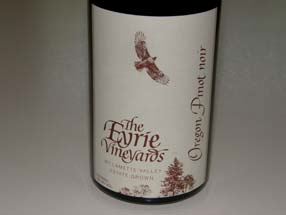 2004 The Eyrie Vineyards Reserve Willamette Valley Estate Grown Pinot Noir 13.0% alc., $60. A vintage marked by extreme weather patterns. Reduced crop levels. · Very attractive aromas of dark red cherries are echoed on the palate with added notes of raspberries and baking spice, and a hint of oak char. Perfectly soft, smooth and understated, even sensual and seductive. Impressive and packed with pinotosity. Currently available for sale on the website.
2003 The Eyrie Vineyards Reserve Willamette Valley Estate Grown Pinot Noir 13.0% alc., $50. One of Oregon’s most unusual and challenging vintages. There were more 100-degree days than ever before creating the hottest vintage anyone had ever seen. Hot winds out of the Columbia Gorge accelerated sugar accumulation. The deep-rooted Eyrie vines managed to pull through the year fine. · Light garnet color. Demure but pleasant fresh red cherry and berry aromas. A delicate wine that is light, soft and smooth with restrained but ample acidity. The elegant red cherry and cranberry flavors are appealing. This wine avoids the problems incurred by a number if producers who were shouldered with overripe fruit, high alcohols and low acids caused by the very warm vintage.
2002 The Eyrie Vineyards Reserve Willamette Valley Estate Grown Pinot Noir 13.0% alc.. Perfect growing season. · Moderately dark reddish-purple color - deepest of the 2002, 2003, 2004 trio. Ripe, even slightly roasted aromas and flavors of cooked cherries, prune, raisin and marzipan. Medium body, smoothly textured with minimal tannins and hi-strung acidity. Quite different from a bottle reviewed in September, 2008.
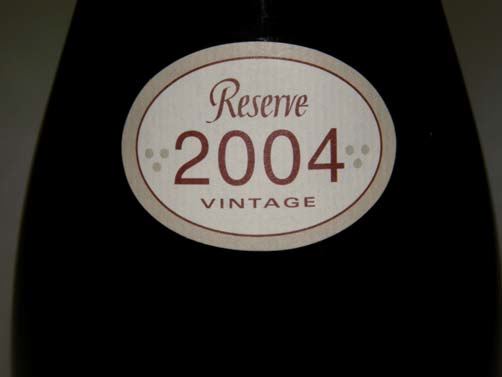
The History of Oregon Pinot Noir ClonesSome of the following information was excerpted from an article titled, “Mothers & Clones,” written by Jason Lett in the Oregon Wine Magazine 2004. The story of Oregon’s quest to import suitable Pinot Noir clones is at the heart of the this state’s wine industry success. The clonal selection chosen for producing Pinot Noir along with the soils, microclimate and viticulture are crucially important in determining the resultant flavor profile of the wine. A clone is a separate vine genetically identical to its mother plant. It has the same growth habit, flavors and ripening time compared to the vine it originated from. Clones are propagated by taking cuttings from a mother vine. Seeds cannot be used since after pollination, the new seeds will not be genetically identical. In the early 1960s, there was only one non-virused University-certified clone of Pinot Noir available in the United States. It was imported to University California Davis from Burgundy, but certified in Switzerland at Wädenswil (UCD 1A and 2A). All Pinot Noir clones and selections planted in North America originally came from France. David Lett brought a carload of Wädenswil clone (UCD 1A ) cuttings from University California Davis to Oregon in 1965. With time, this clone has proven its metal in Oregon. Lett’s 1975 Eyrie Vineyards South Block Reserve Pinot Noir was vinified solely from UCD 1A and won international acclaim. The Pommard clone UCD 4 was brought to Oregon by Dick Erath and Charles Coury. It produced a flavor profile that was complimentary to the Wädenswil clone and is the most widely planted Pinot Noir clone in Oregon. Coury sold cuttings from his nursery that purportedly were Pommard and became known as the Coury clone, but these cuttings, which are widely planted in Oregon vineyards are not the same as Pommard clone, probably represent one or more suitcase selections brought into the US by Coury from Alsace, are not a true clone. In the early 1970s, three Pinot Noir clones were available from Davis: Wädenswil, Pommard and a third minor clone mislabeled as Gamay Beaujolais. There were also a few suitcase selections such as the Coury "clone." Early Oregon Pinot Noirs were often a blend of Wädenswil, Pommard UCD 4, and Coury "clones." Serious viral infestation in Chardonnay and Pinot Noir in France in the 1960s led French officials to start a clonal trial program that led to the discovery of what are now known as the “Dijon” clones. In order to acquire some of these newer clones from Europe, Oregon growers enticed Oregon State University to obtain an import permit from the USDA so that clonal material could be sent directly to Oregon from Europe. Initially they were only able to get low quality Pinot Noir clones. In the 1980s, Dr. Raymond Bernard, one of the developers of clones in Burgundy and regional director of the Office National Interprofessional des Vins (ONIVINS) in Dijon, France, became sympathetic to Oregon’s cause. He had spent time with David Lett in 1964. In 1984, Bernard sent Pinot Noir clones 113, 114, 115, and in 1988, 667 and 777. The laboratory technicians at Oregon State University nicknamed the imported cuttings “Dijon clones” after the return address on the shipping container, and the name has become part of viticulture lexicon and widely accepted. Together they became known as the “Dijon” clones and all are descended from individual plants that grow in vineyards belonging to Jean-Marie Ponsot of Morey-St.-Denis. Dr. Bernard’s donation had a significant influence on the success of Oregon and New World Pinot Noir. Today, there are well over 200 clones of Pinot Noir (some have claimed as many as a 1,000). 50 of the clones are certified and 15 are significantly propagated. The controversy continues over which makes the best Pinot Noir, a wine from a single clone or a blend of clones. In addition, there is an ongoing argument about which is better, official clones or “indigenous clones” from individual vineyards known as selection massale. The latest Dijon clone to appear in Oregon is 828 and its success is unproven. Most recently, certain heritage clones from California have been planted in Oregon vineyards to add to the clonal diversity that is prized by a number of producers. In summary, the clones and selections planted in Oregon now mirror those in California and include UCD 2A (Wädenswil), UCD 23 (Mariafeld), UCD 4 and 5 (Pommard), Dijon 113, 114, 115, 667, 777 and 828, and various suitcase and heritage selections. California has considerably more plantings of heritage clones and selections including UCD 37 (Mt. Eden), UCD 9, 16 (Jackson), UCD 97 (Swan), UCD 32, 33, 41 (Roederer) Calera, Chalone, Rochioli, and Wente.
Report from 2009 IPNC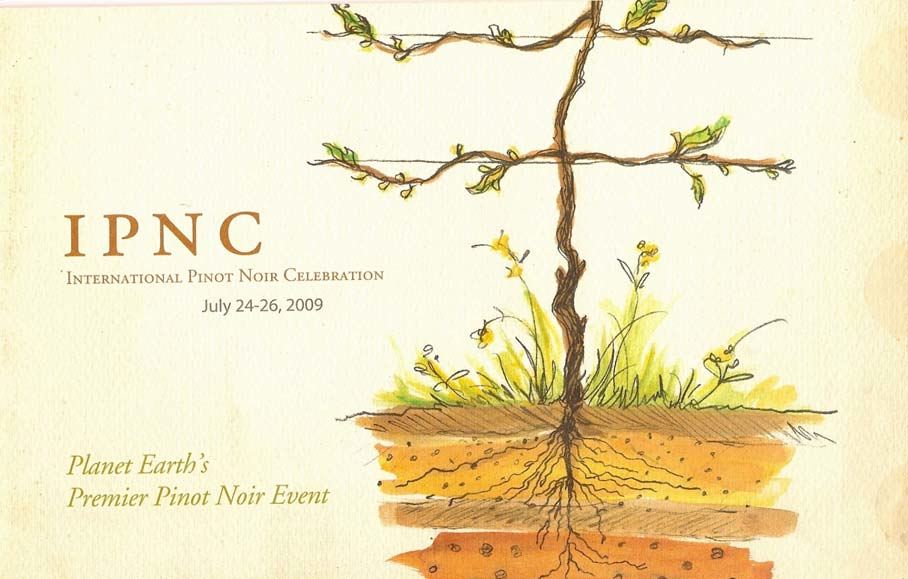
Opening Ceremonies
David Millman of Domaine Drouhin Oregon, the current President of the IPNC, introduced Dr. Thomas L. Hallie,
the President of Linfield College. Linfield is one of the oldest colleges in the western United States, dating to
1849 when Baptists established the institution before Oregon was granted statehood. The small and pastoral
campus is a perfect site for this event. Many attendees stay on campus in student dormitories and apartments.
Hallie is a Pinot Noir lover and can be seen throughout the event mixing with attendees and sharing in the
revelry. Jancis Robinson, world-renown wine educator, was attending her third IPNC, having given the keynote
speech for the first time in 1988. As the Master of Ceremonies, her preview of the event and the status of Pinot
Noir in Oregon was well-received. Each of the 65 featured Pinot Noir producers paraded to the podium and
introduced themselves. Listen to the Opening Ceremonies: “Opening Ceremonies of IPNC featuring Dr. Thomas L. Hallie and Jancis Robinson”
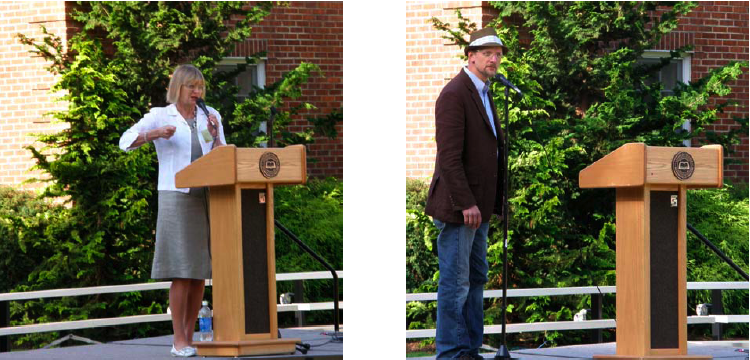
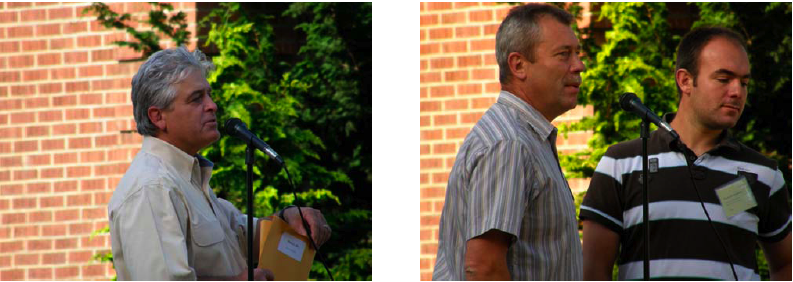

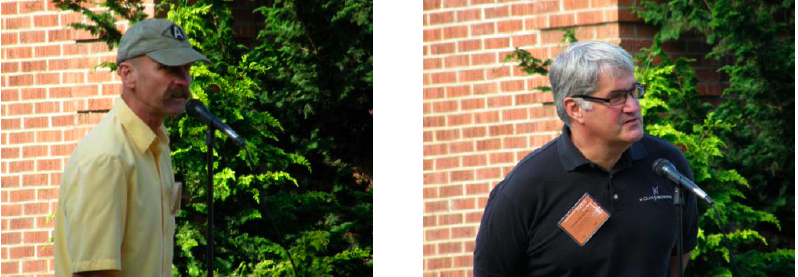
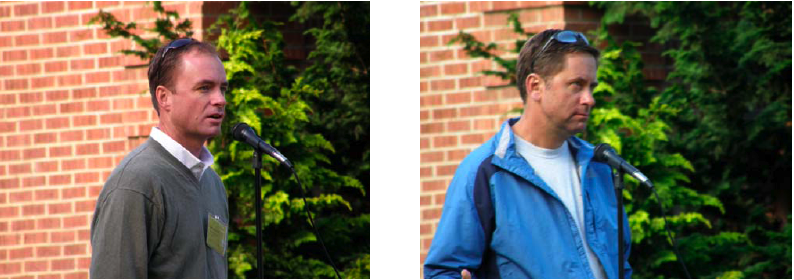
There were approximately 700 registered attendees for the 2009 weekend, including 130 representatives from the 65 featured wineries. The wineries hailed from Austria, Australia, California, Canada, France, New Zealand, Oregon and Washington. There were ten Burgundy producers represented.
Australia: Kooyong Vineyard & Winery (Victoria)
MealsThe meals at the IPNC share the limelight with the wines. 52 guest chefs create the meals served throughout the Celebration along with 40 other professional and amateur chefs who volunteer their time for the IPNC. The lunches and dinners at Linfield College are alfresco affairs. Sample menus are shown below.
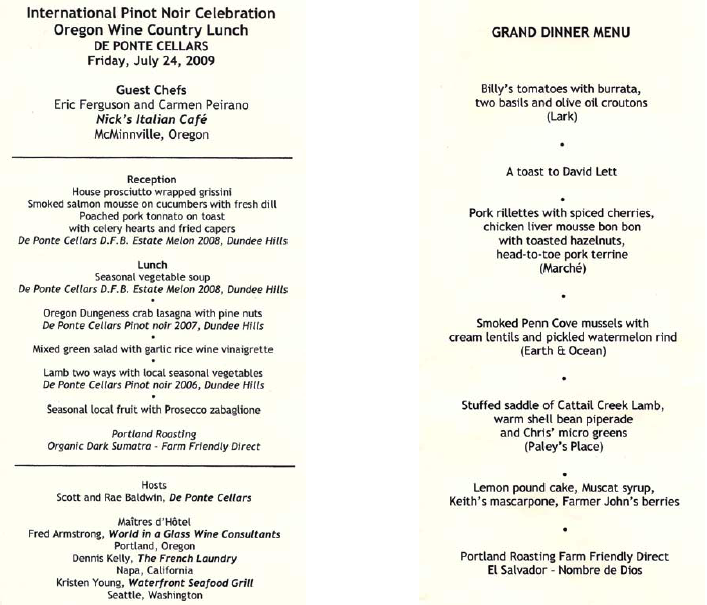 The much-loved Northwest Salmon Bake is held in an oak grove on the Linfield College campus. Now in its 22nd year, it is a tradition at the IPNC. Wild salmon is cooked native Northwest style on wood stakes over a 60’ x 15’ custom-built fire pit fueled by fir and alder woods. Many volunteers from the Depoe Bay Chamber of Commerce brave the heat and provide the succulent salmon each year for the attendees. Wine flows like water at the dinner. Below you can see me reveling with a bottle of Sine Qua Non Hollerin’ M Shea Vineyard Pinot Noir, one of my favorite all-time Pinot Noirs, brought to share by my good friends, Andy and Sue Steinman.
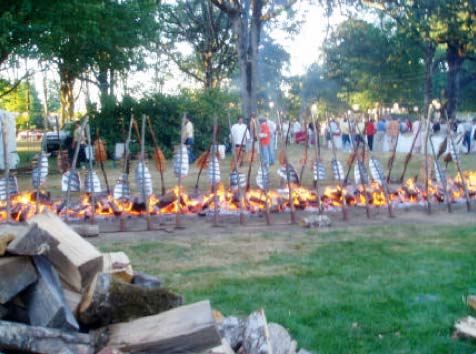
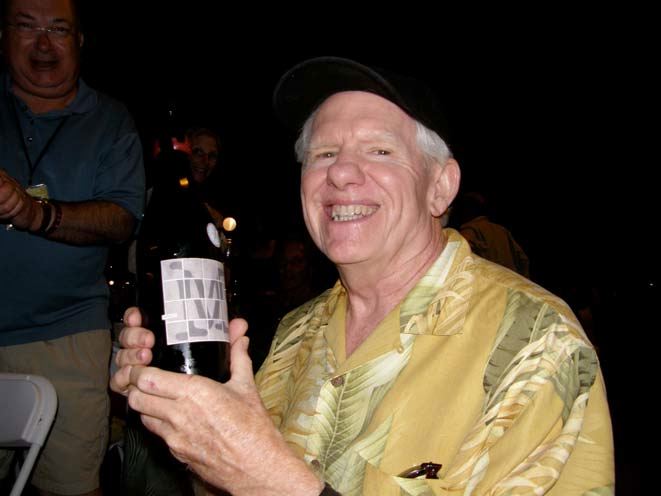
Vineyard ToursGuests are divided into two groups with half of the guests boarding buses and fanning out over the Willamette Valley to various vineyard designations. The other half stay on campus for seminars. The groups switch the following day. The winery of designation is a secret until your bus leaves the campus. Once at the winery, guided walks of the vineyards were followed by talks about the soils and geologic history of the area, as well as distinct characteristics of the host vineyard in keeping with this year’s IPNC emphasis on terroir. The Oregonians are soil freaks and never to seem to tire from endlessly talking about the “mother” earth their vines are planted in. I traveled to De Ponte Cellars on Archery Summit Road in the Dundee Hills. De Ponte Cellars is owned and operated by the Baldwin Family who bought the vineyard in 1999. The name De Ponte, honors the owner’s Portuguese maternal grandfather, Manuel De Ponte. The vineyard is planted to 14 acres of several clones of Pinot Noir and just over 3 acres of head-pruned Melon de Bourgogne (Muscadet), planted back in 1975. The Melon planting is believed to be the oldest in Oregon.
Although Oregon has staked its claim on Pinot Noir, white varieties have achieved considerable success of late. Pinot Gris has been the most widely planted white grape and is Oregon's signature white wine, but I have also tasted superb examples of Oregon Riesling, Chardonnay, Pinot Blanc, Melon, Rousanne and Pinot Noir Blanc. Oregon Pinot Gris is usually unoaked and is often more full-bodied and flavorful than California versions (think Alsace Pinot Gris versus Italian Pinot Grigios). In 2000, Pinot Gris overtook Chardonnay as the most widely planted white variety in Oregon. See my recent report on Oregon Pinot Gris. A group of Chardonnay producers believe that world-class Chardonnay can be produced in Oregon with the use of the proper Dijon clones. Early on, Oregon planted Chardonnay clones such as UCD 108 and UCD 2A (Wente) that were more suited to California's warm climate. Wide spacing of the vines and the use of rootstock that restricted growth led to slow ripening of grapes. Now vines are planted with rootstocks that limit vigor and are tighter-spaced. Seven notable Willamette Valley wineries have formed the Oregon Chardonnay Alliance (ORCA) to promote the “rebirth” of Oregon Chardonnay (www.oregonchardonnay.org). The wineries include Adelsheim Vineyard, Argyle Winery, Chehalem, Domaine Drouhin, Domaine Serene, Hamacher Wines and Ponzi Vineyards.
 I am particular partial to Pinot Blanc, a genetic mutation of Pinot Noir, which is often vinified like Chardonnay using oak barrel malolactic fermentation. The wine's high acidity and appealing apple and nutty flavors make for an interesting alternative to Chardonnay. I have had excellent examples from Ken Wright, The Four Graces and Anne Amie. Pinot Noir Blanc has become more than a curiosity. Pinot Noir purposely vinified in a white wine style has aroused serious interest as an alternative white wine. Excellent examples are produced by Anne Amie and Domaine Serene.
Almost all the great Willamette Valley Pinot Noir vineyards are situated on rocky hillsides that face south or southeast, between 200 and 800 feet above sea level. The photo below is taken at the De Ponte Vineyard and shows the De Ponte viticulturist in the forefront with the view from the site in the distance looking southeast. The soils at De Ponte Vineyard are Jory type and red in color, lending the name “Red Hills of Dundee” to the area (also visible in the photo). The red color is derived from oxidized iron in the soil. Jory soils are basaltic or volcanic in type originating from ancient lava flows from eastern Washington and Oregon. These soils are also found in the Chehalem Mountains and Eola-Amity Hills AVAs. According to Andy Gallagher (www.redhillssoils.com), “The underlying soil is red clay, with upwards of 60 percent clay. A specific feature of Jory is that despite the high clay content, the combination of mineralogy, organic matter and strong structure causes the soils to behave like soils with less clay. The soils have a potential to yield moderately high to high vine vigor and have ample water holding capacity for dry land viticulture.”
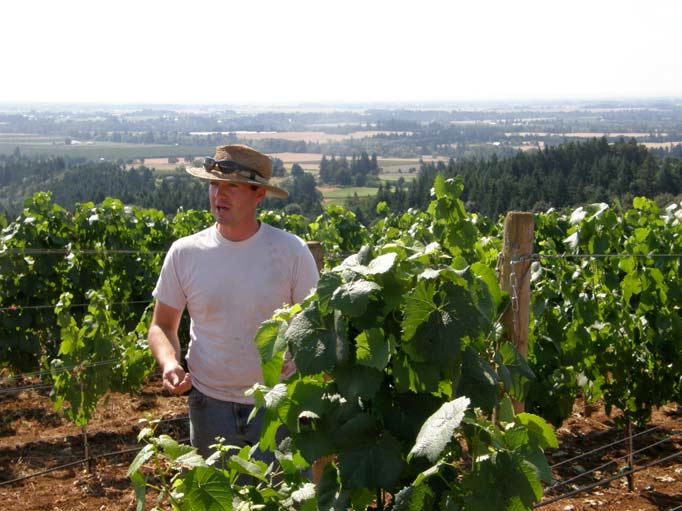 The first and only winemaker at De Ponte Cellars since 2001 is Isabelle Dutartre who has over 25 years of experience in making wine in both France and the Dundee Hills. She assisted Veronique Drouhin at neighboring Domaine Drouhin for five vintages, and after traveling back and forth between Oregon and France for a number of years, is now permanently rooted in Oregon. The De Ponte style features wines of elegance and refinement. Current releases include the 2008 De Ponte Cellars D.F.B. Estate Melon (bright and fresh with notes of apples, pears and vanilla, $24), 2007 De Ponte Cellars Dundee Hills Pinot Noir (20% new French oak, fabulous wine featuring red fruits, spice, bright acidity and gossamer tannins, 1,700 cases, $38), 2006 De Ponte Cellars Dundee Hills Pinot Noir (a beautiful wine that is delicate for the 2006 vintage with charming red stone fruit and berry flavors, supported by supple tannins and ample acidity, 2,400 cases, $38), and the 2007 De Ponte Cellars Dundee Hills Estate Pinot Noir (primarily for wine club members, higher percentage of new oak, sourced from selected blocks, more intensity and nuances with a persistent finish, 196 cases, $55). Magnums of all the wines are available. The comfortable tasting room at De Ponte Cellars is open daily from 11:00 AM to 5:00 PM at 17545 Archery Summit Road in Dayton. Combine a visit with neighboring Domaine Drouhin, Archery Summit and White Rose Vineyard & Winery, all of which have tasting rooms nearby that are open daily.
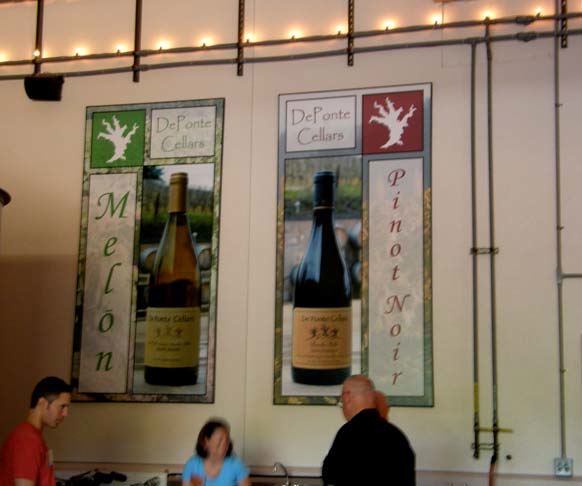 SeminarsDown to Earth: Digging Deeper into Oregon’s Soils
The “5-5-5” project involved the above five winemakers, five vineyards (Abbott Claim Vineyard in Yamhill- Carlton AVA, Eileen Vineyard in Eola-Amity Hills AVA, Willakia Vineyard in Eola-Amity Hills AVA, Bethel Heights Southeast Block Vineyard in Eola-Amity Hills AVA, and Leah’s Vineyard in the Chehalem Mountains AVA) and 5 lots of 2006 Pinot Noir from each vineyard. Vineyards were chosen for uniformity so each winemaker received essentially the same 1.25 tons of grapes. The grapes were picked from each vineyard on the same day for each winemaker. Vinification was individualized by each winemaker. Wines from two vineyards were offered blind to the seminar attendees. The seminar I attended had wines from Willakia Vineyard and Southeast Block Vineyard of Bethel Heights. For me, each of the five wines made from a single vineyard were quite different and although I could pick up some commonality to the fruit profile and tannin structure of the vineyard, the hand seem to be more evident than the terroir. One attendee correctly identified all five winemakers, although I did not see anyone who picked out both vineyards (I correctly identified the Southeast Block flight). Cellar Crawl is offering a set of 5 boxes, 5 bottles per box of the 2006 Pinot Noir made for this experiment. Each box contains five winemakers’ versions of a single vineyard. 20% of the cost, $1,250, will be donated to the Parkinson Center of Oregon in honor of Terry Casteel who is battling Parkinson’s Disease. Contact any of the five wineries to order your set. (Note: Terry Casteel’s son, Ben, who is now co-winemaker at Bethel Heights, made the wines for Bethel Heights, and Ted Casteel was the speaker representing Bethel Heights at the Seminar.) Each of the five winemakers spoke at the Seminar about the spirit of collaboration that has pervaded the Oregon wine industry from the beginning. In speaking casually with several California winemakers attending IPNC, they seemed envious of the degree of cooperation among Oregon wineries. Steve Doerner outlined the significant events in Oregon’s young wine history that were the result of this collaboration:
•1977: Labeling Regulations. Oregon has the most restrictive labeling laws in the country. For example, when a grape variety name is on a bottle, the bottle must contain 90% of that variety The national law is 75%. European wine names such as Chablis are not allowed. •1979: Steamboat Conference. Now an international event attended only by winemakers who critique each others’ wines. •1979: Wine Advocacy Board. Oregon has the highest taxes for wineries devoted to marketing and research. •1987: International Pinot Noir Celebration. The oldest Pinot Noir festival of its kind. •1992: ¡Salud! Barrel Auction. Benefits the health care of Oregon’s vineyard and winery workers. •2000: Pinot Camp. 50 wineries host 270 industry trade people from all over the country to educate them about Oregon Pinot Noir. •Sub-AVAs of the Willamette Valley. Still controversial, but based on consensus and cooperation. The six sub-AVAs are largely based on the parent soil.
Eola-Amity Hills AVA: mostly basaltic, but marine sedimentary at the lower elevations on the western and northern slopes Chehalem Mountains AVA: basaltic and marine sedimentary on the southern and western slopes; ice-age loess on the northeastern slope Yamhill-Carlton District AVA: marine sedimentary predominant Ribbon Ridge AVA: marine sedimentary McMinnville AVA: primarily marine sedimentary with some basalt and alluvium Why so much emphasis on the parent soil? The flavor of Pinot Noir is dependent on the mother rock in which it is grown. Basically, the soils of the Willamette Valley are marine sediments with basalt or volcanic mantle in the Dundee Hills, Chehalem Mountains and Eola-Amity Hills. The volcanic material did not arise in these areas but is the result of lava flows from the Blue Mountains of Eastern Washington. Laurent Montalieu spoke about the advances in viticulture which have contributed to the success of Oregon wine:
•Tighter spacing. In 1987 the norm was 10’ x 5’ or 10’ x 6’. Today, the spacing is significantly tighter with ranges of 4’ x 4’ to 1’ x 1’ (1,200 to 2,000 plants per acre). •Crop levels. Yields determine quality of the wine. Crops are thinned traditionally at veraison. Experiments conducted in Oregon over the past four years have shown that crop thinning can be performed shortly after set is completed. Earlier seems better. Lowering crop levels in Oregon is crucial to cut time off the end of the growing season and avoid the rains. •Contracts by acre. Winemakers now contract for their fruit by the acre, not by the ton. This allows them to control yields and the resultant quality. •Equipment. Newer equipment provides for gentle handling. Nearly all wineries now have sorting tables. Gravity flow techniques are the norm, either through structural means or forklifts. •Several other factors are evident but were not touched on by Montalieu: matching clones to rootstocks, proper canopy management to expose the grapes gently to the sun, and discovery of the most optimum vineyard sites.
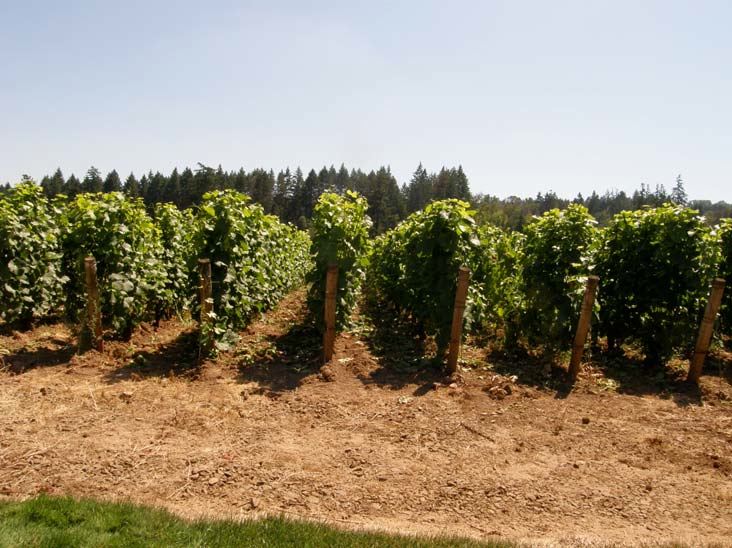
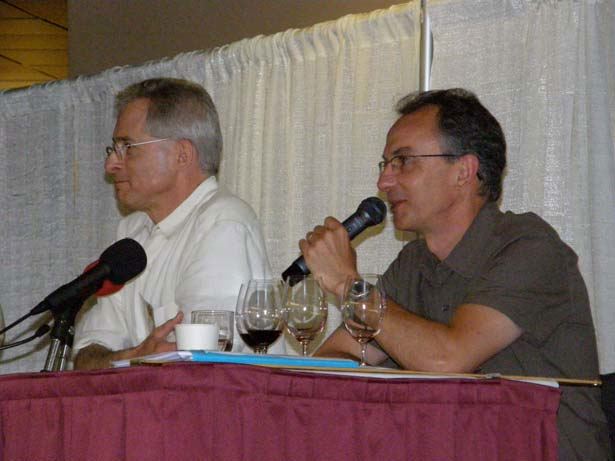
Honestly, this seminar was not as successful as the one presented at the World of Pinot Noir in 2005 in which
manager Jean-Luc Pepin and Allen Meadows presented a tasting of three vintages of Grand Cru Musigny
Vielles Vignes, Grand Cru Bonnes-Mares and 1er Cru Les Amoureuses. Meadows was able to translate for
Pepin making the seminar more understandable. Although Millet’s English is very credible, I was unsuccessful
in getting him to hold the microphone properly and he comes across very soft spoken and somewhat muddled
on the recording. In addition, I met with background noise in the recording which was not evident until after the
Seminar. I have posted the recording among my podcasts and if you listen carefully you will be able to discern
some valuable information. Without the maps and illustrations, the discourse on geology is difficult to follow.
Listen to the recording: “Tour de Chambolle-Musigny featuring David Schildknecht and Francois Millet” Domaine Comte Georges de Vogüé dates back to 1450 and is considered the greatest estate in Chambolle- Musigny. The Domaine owns 6.46 hectares or 80% of the red Le Musigny Vineyard, along with 0.65 hectares of white Musigny, 2.75 hectares of Bonnes-Mares (bone-mar), 0.56 hectares of Les Amoureuses, 0.13 hectares of Les Boudes, 0.14 hectares of Les Fuees, and 1.81 hectares of 1er Cru Chambolle-Musigny. The winery is run by estate manager Jean-Luc Pepin, winemaker Francois Millet and the aptly named vineyard manager Eric Bourgogne. The estate has been owned by the same family for generations. Chambolle-Musigny is “the” commune in Burgundy, possibly rivaled by only Vosne-Romanee and Volnay. The unique and highly desirable wines show richness, fine tannins, a delectable balance between sweetness of fruit and minerality, and spice, depth and delicacy. They have “power without weight,” and seem to float across the palate. Millet spoke of a special tension or energy that the wines possess. The Musigny and Bonnes-Mares were compared and contrasted. Each of the two vineyards have about the same situation on the Cote hillside but the mother rock or topsoil is different. The Bonnes Mares soil is composed of more clay, possesses slightly less drainage and the slope is less steep. The result is that the Bonnes Mares has black fruit, blueberry and heavy rose features. It is earthy and tannic, austere and angular when young, and often requires at least 20 years of bottle age to develop. In comparison, Le Musigny combines the power of Bonnes Mares with the seductive elegance of Les Amoureuses. It displays redder fruit and a more delicate rose incarnation. Despite its charm, it can age for decades. The Domaines vineyards are farmed “as organically as possible,” meaning ho herbicides or insecticides, but if disease pressure should arise, systemic products are employed once to control the problem. Millet stated, “biodynamics is very courageous,” but not employed at the Domaine.
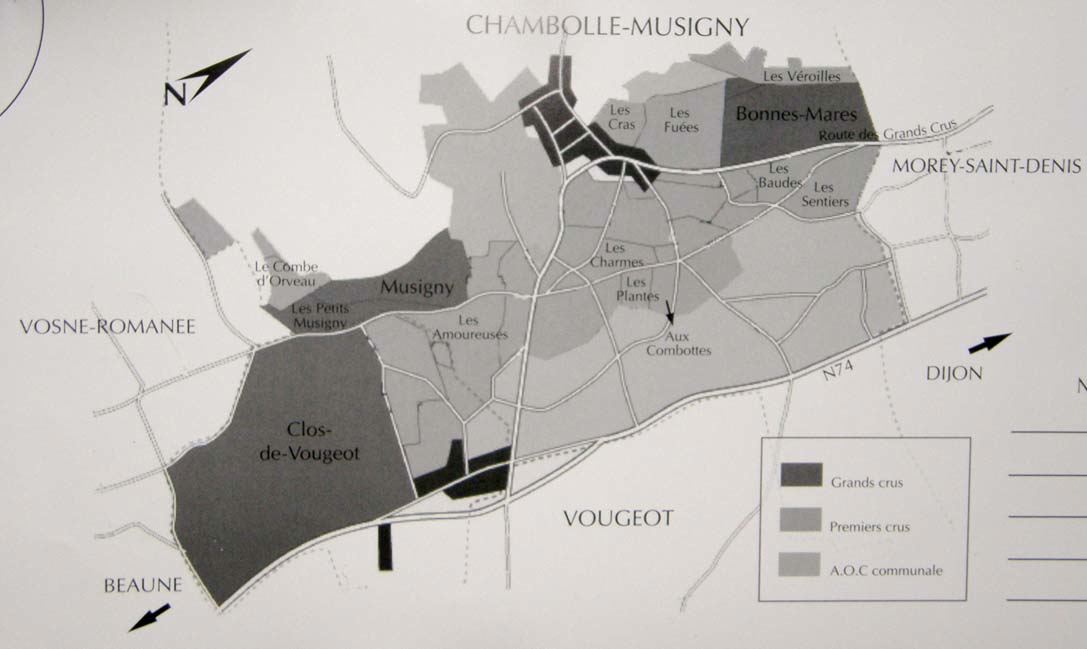
2006 Domaine Comte Georges de Vogüé Chambolle-Musigny $110-$150. Village-level wine. · Light-bodied, demure red fruit aromas and flavors with a notable acid spine producing an uplifting tartness.
2006 Domaine Comte Georges de Vogüe 1er Cru Chambolle-Musigny $194-$250. Sourced from the young vines in the Le Musigny vineyard (10-25 years old). This wine is more reflective of the personality of Chambolle-Musigny terroir than the Village wine. · Moderate garnet color. More fruit extract and more character than the Village wine. Very charming spiced cherry and berry and forest floor aromas that carry over to the flavor profile. The wine has soft but firm tannins with a lively grip of acidity on the refreshing finish. This is an impressive wine that will stay the course for many years to come.
2006 Domaine Comte Georges de Vogüé Bonnes-Mares $295-$450. · Moderately dark garnet color. A thick wine with expressive aromas of dark red stone fruits and violets. Rich and full-bodied on the palate with noticeable fine-grain tannins and a lingering finish that features a return of the aromas offered on the nose. Needs time to resolve and soften the angular and imposing structure
2006 Domaine Comte Georges de Vogüé Musigny Vielles Vignes Vignes $380-480. From vines that average years old (26-55 years old). · Moderate garnet color. Red raspberries and cherries dominate the restrained nose. Well-endowed core of red fruits flush with minerality and perfectly complimented by supple tannins and soft acidity. The finish is impressively long and aromatic. Still tight and no where near what it will be in ten to twenty years.
 The prices are astonishing, but this Domaine’s wines are a luxury product that satisfies a demand. Your best option might be to befriend someone else who has the means to buy these exemplary Burgundies.
Pinot Noirs that Impressed at Alfresco TastingsAt the IPNC, there are alfresco tastings in the late afternoon on successive days where the featured wineries pour their wines. This is not a venue for serious wine tasting, but some impressions can be gathered. There are certain wines that stand out and I have listed below wines that deserve your special attention. Kooyong Vineyard & Winery 2007 Ferrous Single Vineyard The Kooyong Vineyard and Winery are located at Tuerong on the northern end of the Mornington Peninsula, about an hour’s drive south of Melbourne, Victoria, Australia. Kooyong was established in 1995 on a gentle undulating 250 acre property. The Kooyong name means “where the wild fowl gather,” and is derived from the property’s location neighboring Devilbend Reserve, the home to many native water birds. Kooyong has 75 acres of vines planted to Pinot Noir, Chardonnay and Pinot Gris. The winemaker is Sandro Mosele who focuses on preserving the region, the variety and the site where the grapes are grown. Schloss Gobelsburg 2002 Alte Haide Magnum Schloss Gobelsberg is the oldest winery in the Danube area of Kamptal with a documented viticultural history dating back to the 12th century, when Cistercian monks from Burgundy started to work their first vineyards in the area. Gobelsburg has been run by Michael Moosbrugger since 1996. Grüner Veltliner and Riesling are the winery’s most important varieties.
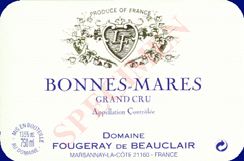 Domaine Fougeray de Beauclair 2007 Bonnes-Mares This Domaine is a regular visitor to the IPNC and the winery’s Bonnes-Mares is unique in that it is very approachable soon after release. Imported by Triage Wines in Oregon and Washington (Le Serbet, Becky Wasserman Selections). Our table was treated to the 2003 version of this wine at the Friday night Grand Dinner and it was easily the wine of the event for all of us who tasted it. Domaine Fourrier 2007 Gevrey 1er Cru, Clos St. Jacques Previously known as Pernot-Fourrier, Domaine Fourrier has a long history in Gevrey Chambertain extending over four generations. With 22.5 acres of vineyards in the communes of Gevrey Chambertain, Morey-Saint-Denis and Chambolle-Musigny, this Domaine is one of the most well-endowed estates. Vines average between 50 and 70 years of age. Jean Marie Fourrier took the reigns in 1994 and was able to combine the traditions of his father, his experience gained while working with Henri Jayrer and Domaine Drouhin Oregon, and his own clear sense of style. Ever since his ascension, the wines of Domaine Fourrier have garnered critical acclaim. The trio of wines I tasted from this Domaine at IPNC were very, very impressive. Les Champeaux and Clos St. Jacques are clearly two wines to buy from this vintage. Imported by Neal Rosenthal. Domaine Philippe et Vincent Lecheneaut 2007 Nuits-Saint-Georges 1er Cru Les Pruliers Fernand Lecheneaut created this 22-acre estate in the early 1960s while working for a negociant in Beaune. He took advantage of opportunities to buy parcels of various vineyards when they became available and eventually quit his negociant position when he had acquired enough vineyard acreage. His sons Phillipe and Vincent took over in 1985. All of their vines are in the Cote de Nuits, spread throughout Nuits-Saint-Georges, Morey-Saint- Denis, Vosne-Romanee, and Chambolle-Musigny with a small parcel of the Grand Cru Clos de la Roche. The Domaine produces 13 different bottlings yearly, totaling 6,000 cases. Domaine Michele et Patrice Rion 2006 Nuits-Saint-Georges 1er Cru Clos Saint Marc. This Burgundian estate was created in 1990, beginning with only 2.5 acres of vines. Today, the Rions have 22 acres from five different communes. Until 2000, Patrice was the winemaker at Domaine Daniel Rion & Fils. The 2006 Clos Saint Marc was the first vintage to bear the Rion name as the vineyard was only acquired in 2006. Domaine Marc Roy 2006 Clos Saint Landelin Domaine Marc Roy has been in the family for four generations. The estate includes 9 acres of Pinot Noir and 1 acre of Chardonnay, producing about 1,800 cases annually. Owner and winemaker, Marc Roy, inherited his love for winegrowing from his father and grandfather. His daughter, Alexandrine, took over the job of winemaker and manages the vineyard with her father.
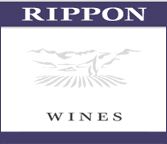 Rippon Vineyard & Winery 2006 Rippon Pinot Noir Rippon has been cared for by the Mills family for four generations and its vines have had their roots deep within the site’s schist-laden soils for over 25 years. Nick Mills, the son of Central Otago’s viticulture pioneers Rolfe and Lois Mills, was born at the same time as his parents’ first plantings. Nick lived in Burgundy from 1998 to 2002, where he graduated from the CFPPA de Beaune and worked in several of France’s most esteemed estates including Domaine Jean-Jacques Confuron and Domaine de la Romanee-Conti. He returned to Rippon in 2002 and has applied biodynamics to the farming of the Rippon vineyard. He is currently the President of the Central Otago Winegrowers’ Association and has played a key role in Central Otago’s region-wide organic initiative. Imported by Station Imports, Colorado. Hanzell Vineyards 2006 Winemaker’s Block Sonoma Valley Pinot Noir and 2006 Sonoma Valley Pinot Noir In 1953, Ambassador James Zellerbach founded Hanzell Vineyards on a 200-acre estate perched in the hills high above the town of Sonoma. The original vineyard block is now the oldest producing Pinot Noir vineyard in the New World. The winery’s vineyards are planted on the rocky and steep slopes that surround the winery. Today, the winery produces 6,000 cases of estate-bottled Chardonnay and Pinot Noir. The focus and hallmark of Hanzell wines is their structure and long term age ability in the tradition of Grand Cru Burgundy. Michael McNeil is the winemaker and I was fortunate to sit with him at a pre-IPNC dinner. He is a bright and passionate winemaker who shared the wonderful 2006 Hanzell Pinot Noir at dinner. Hanzell wines are a California treasure and ones you must try if you are a devoted pinot aficionado. LIOCO 2007 Michaud Vineyard Chalone Pinot Noir LIOCO is the result of years of conversation between Matt Licklider (a wine import specialist) and Kevin O’Connor (former wine director at Spago Restaurant in Beverly Hills) about whether California could produce a true “wine of origin.” After gathering opinions on the subject from some of the world’s great wine producers, they arrived at the conclusion that California could achieve a wine of origin, provided certain protocols were adhered to in the vineyard and in the cellar. Inspired by traditional European winegrowing practices, LIOCO seeks out vineyard sites with tougher soils, older vines and select clones. They then shepherd the grapes from bud to bottle in the least intrusive way possible. Kevin Kelley is the talented winemaker. LIOCO’s focus is on naturally fermented Chardonnay (in stainless steel) and Pinot Noir (in neutral or very low percentage new French oak). Bergström Wines 2007 Bergström Vineyard Pinot Noir Bergström Wines is a family owned and operated business located outside Newberg on the southern facing hillsides of Chehalem Mountains. Three estate vineyards in the Chehalem Mountains and Dundee Hills total 35 acres, and are all farmed biodynamically (Demeter certified). Bergström produces small lots of Pinot Noir (8,000 cases), Chardonnay (800 cases) and Riesling (800 cases). Josh Bergström is the general manager, winemaker and vineyard manager.
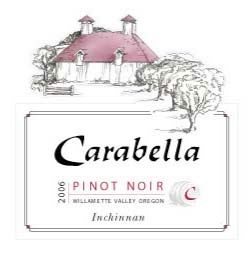 Carabella Vineyard 2006 Inchinnan Pinot Noir Geologist and winemaker Mike Hallock produces estate-grown wines from a hillside vineyard which represents the culmination of a 12-year search for an appropriate location to combine the best of Oregon and French terroir. Pinot Noir is the main emphasis, with five clonal blocks fermented separately, then blended to show the complexity of the vineyard. Carabella also produces a Pinot Gris and Dijon 76 clone Chardonnay. Cristom Vineyards 2007 Eileen Vineyard Eola-Amity Hills Pinot Noir The BEST wine I tasted from Oregon at the alfresco tastings. In 1992, Paul and Eileen Gerrie established Cristom Vineyards and lured talented winemaker Steve Doerner from Calera Wine Company in California and vineyard manager Mark Feltz. The estate consists of more than 50 acres on an east-facing slope in the Eola Hills with high-density planting of Dijon clones on specifically selected rootstocks. Cristom’s techniques include up to 50% whole clusters, native yeast fermentations and bottling without filtration. Pinot Noir, Chardonnay, Pinot Gris and Viognier production totals 9,000 cases annually. Dobbes Family Estate Winery 2006 Quailhurst Vineyard Chehalem Mountains Pinot Noir Joe Dobbes began his winemaking career apprenticing with wine masters in Germany and France before applying his skills to craft wine for several esteemed Oregon wineries including Willamette Valley Vineyards. Dobbes operates Wine by Joe, LLC, a multitiered business that produces three brands: Dobbes Family Estate, Wine by Joe, and Jovino Oregon Pinot Noir. Pinot Gris, Viognier and Syrah round out the portfolio.
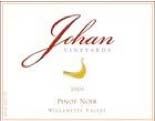 Johan Vineyards 2006 Johan Vineyards Pinot Noir Winemaker Dan Rinke graduated from California State University Fresno and became an assistant winemaker at Domaine Alfred in the Central Coast of California. He moved on to Rhys Vineyards in the Santa Cruz Mountains for a year and then became the vineyard manager and winemaker at Johan Vineyards in 2007. This is a new and promising producer of Oregon Pinot Noir. Shea Wine Cellars 2007 Pommard Clone Yamhill-Carlton District Pinot NoirFounded by Dick and Deirdre Chea in 1996, Shea Wine Cellars produces Pinot Noir and Chardonnay sourced from the famed Shea Vineyard. Shea Vineyard was first planted in 1989 in a then untried viticulture area. The 200-acre property lies in the Yamhill-Carlton District and supplies fruit to some of Oregon and California’s finest wineries. Current production at Shea Wine Cellars is 5,200 cases of Pinot Noir and 400 cases of Chardonnay. The winemaker is Drew Voit.
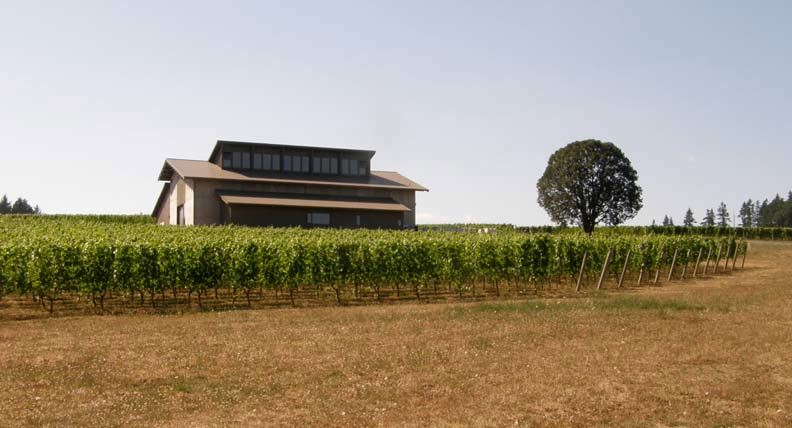 Soléna Cellars 2006 Domaine Danielle Laurent Yamhill-Carlton District Pinot Noir Laurent Montalieu and Danielle Andrus-Montalieu came together to create a family operated winery, Soléna Cellars. Soléna is the combination of the words ‘sun’ and moon’ in French and is the name they gave to their daughter. Soléna Cellars was founded in Carlton in 2002. All the vineyards from which they source, including the estate Domaine Danielle Laurent Vineyard (also known as the Wedding Vineyard because guests to the couple’s wedding were asked to bring a vine in place of a gift and the vines were then planted in the couple’s vineyard) and the historic 100-acre Hyland Vineyard are cropped to low yields and produce high-quality fruit. Vineyard management techniques explore all aspects of viticulture, including biodynamics. Note Laurent’s Chihuahua below, the smallest vineyard dog I have ever seen.
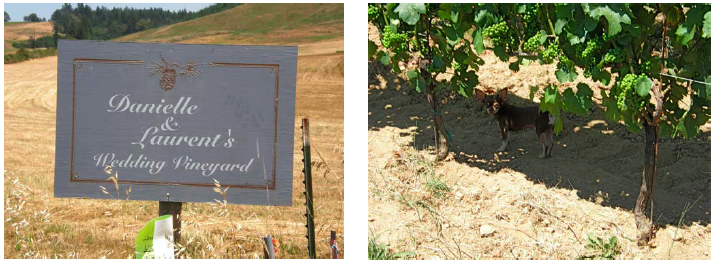
Roots Winery: Solid and Reasonable PinotsRoots Winery is a family affair owned by Christian (Chris) and Hilary Berg. Hailing from Racine, Wisconsin and raised in Idaho, Pennsylvania and Illinois, Chris became interested in wine when his parents bought a manufacturing company in Tualatin, Oregon and moved west from Illinois. The Berg family bought a 20-acre property near Yamhill in the Yamhill-Carlton District located in the same hillside area as Shea Vineyard. In 1999, they planted a 7-acre estate vineyard primarily to Pinot Noir with a small amount of Pinot Gris. Pinot Noir clones 113, 114, 115 and 777 are planted on Willakenzie soil. Chris gained experience in winemaking at Archery Summit Winery. In 2001, Chris and Hilary moved to the Yamhill property and took over management of the property when their parents retired to Wickenburg, Arizona. The name, Roots, is derived from the French word racine which means “roots.” 2002 was the first vintage produced a whopping 72 cases of Pinot Noir under the Roots label. In 2003 a reserve bottling, Racine, was introduced and in 2004, a third label, Klee, was added, which pays homage to Bauhaus artist-in-residence Paul Klee. By 2006, the estate vineyard was in full production and grapes were bought (Cherry Grove Vineyard, Apolloni Vineyard, Leroy Vineyard and 49 Rows Vineyard) to produce a total of 2,000 cases under the three labels. Chris also sources grapes for non-Pinot Noir wines from the Walla Walla and Columbia Valley regions of Washington. Chris Berg’s idea is to make affordable wines and he has accomplished that with his five 2007 Pinot Noirs priced at $25 and the 2006 Racine at $50 (but available as low as $35). Beyond the prices though, Chris’s wines are impressive and deliver plenty of pleasure. I met Chris at this year’s Pinot Days and found him to be a good guy to hang with as well.
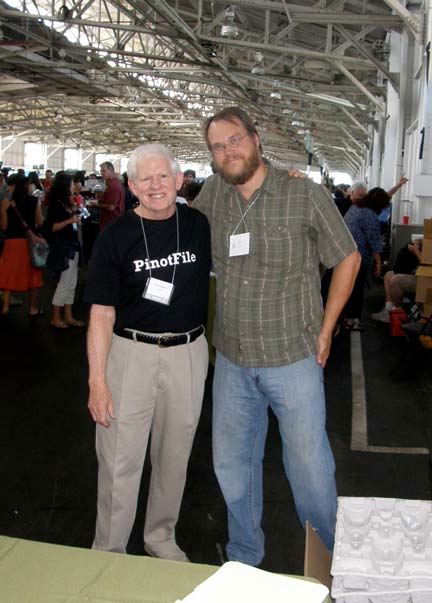
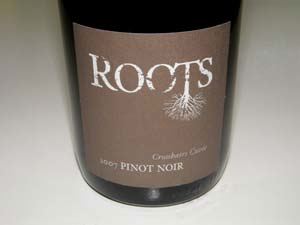 2007 Roots Crosshairs Cuvée Pinot Noir 13.5% alc., 275 cases, $25. Sourced from Leroy Vineyard in the Chehalem Mountains AVA and Cherry Grove Vineyard in the Yamhill-Carlton District AVA. · Moderately light garnet color. The aromas explode in the glass over time revealing black cherries, baking spices, herbs and forest floor. Light in weight and elegant in style with an earthy undertone. Softly textured with gossamer tannins and a good acid spine. A feminine styled wine with enough cleavage to please.
 2007 Roots Estate Yamhill-Carlton District Pinot Noir 13.6% alc., 175 cases, $25. · Pleasing scents of, strawberries, tutti-fruity and spice. Substantial red cherry and red berry core with an underpinning of earthiness, spice and Dr. Pepper. Minimum dusty tannins make the wine very approachable now. Seems like a Yamhill-Carlton wine masquerading as a Dundee Hills wine. This wine really brings it for the price of a Jackson and is recommended.
Roots also has three 2007 vineyard-designate Pinot Noirs from Leroy Vineyard, Cheery Grove Vineyard and 49 Rows Vineyard. The wines are in retail distribution (try www.avalonwine.com in Oregon, www.winex.com in California). I have read stunning reviews for the 2007 Roots Viognier (175 cases, $18) which is sourced from Washington. One reviewer wrote, “This guy nailed Viognier like few we have ever tasted outside of Condrieu. On that point alone it’s noteworthy. The price is a bonus.”
O’Reilly’s Oregon Value PinotsDavid O’Reilly is one lucky Irishman - he makes his living by drinking. A native of Belfast, Ireland, O’Reilly came with his family to Canada, subsequently worked at a small winery while attending college and went on to start his winemaking career at Elk Cove Winery. He met Peter Rosback, another lover of wine of Irish heritage, and together they left Elk Cove Winery in 1998 to start Sineann. O’Reilly was also to form a partnership with viticulturist Jerry Owen known as Owen Roe, which is the name of a 17th century Irish patriot who dedicated his life to upholding the highest principles of political equality and freedom. Together they also founded two value oriented wine labels, O’Reilly’s and Sharecropper’s, which have been produced by O’Reilly for over ten years. These wines are made from Pacific Northwest juice that doesn’t quite fit the recipe for Owen Roe wines. These two wines are among the first releases from the stellar 2008 vintage in Oregon and show a tad better balance and more pleasing textures than the 2007 versions.
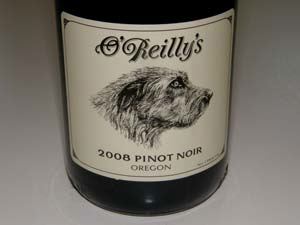 2008 O’Reilly’s Oregon Pinot Noir 13.0% alc., $17. This wine is consistently one of Oregon’s favorites in the under $20 price range. The Irish wolfhound on the label was a pub dog at an Irish restaurant and bar that O’Reilly’s cousin owns in San Francisco. Aged in 3 and 4 year old oak barrels. · A shy and refined aromatic profile of dark berries with a hint of spice. I liken it to fruit in a tuxedo. Tasty dark red fruits with a hint of oak framed by fuzzy tannins and ending in a dry finish. A bright and charming wine that works as a go-to drinker.
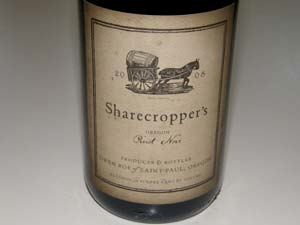 2008 Owen Roe Sharecropper’s Oregon Pinot Noir 13.0% alc., $21. · Deep ruby color. Amazing nose of crushed berries with a lovely roseate accent and some subtle oak toast in the background. Light in style and soft in texture with more restrained acidity than the 2007 version. Earth and oak notes in the background augment the berry flavors. A little lacking in the short finish, but overall this is a very pleasant drink for the tariff.
Both of these wines enjoy wide retail distribution but availability is reduced because production in 2008 was decreased by 25%.
Antica Terra Speaks of TerroirA pair of New Yorkers started Antica Terra in 1989. Co founder and winemaker Marty Weber made small amounts of highly lauded Pinot Noir from the 6-acre estate vineyard located on 40 acres in the Eola-Amity Hills appellation of the Willamette Valley. The vineyard is located on a south-facing sloping hillside with shallow well-drained soil underlain with marine sedimentary rocks and alluvial deposits, hence the name “Antica Terra,” Latin for “Old Earth.” The stratification of the earth in the Antica Terra Vineyard is depicted on the label. The Antica Terra Vineyard and label were acquired in June of 2005 by three friends (Scott Adelson, John Mavredakis, and Michael Kramer), and talented winemaker Maggie Harrison. Harrison assisted Manfred Krankl at Sine Qua Non in Ventura, California for eight years. She was so fond of working with Krankl that he had to practically lock the doors to his winery to force her out on her own. It was only the unique opportunity afforded by Antica Terra in Oregon that led her to take the leap. Listen to Maggie’s full story in an interview with myself, Brian Clark and Jay Selman on Grape Radio Show #232 at http://www.graperadio.com/archives/ 2009/02/02/life-with-maggie/. In 2007, 20 additional acres of Pinot Noir were planted with upgrades to the clonal and rootstock mix. A new winery is being built in Dundee scheduled for completion in 2009. The inaugural release by Maggie Harrison was the 2006 vintage (the 2005 vintage was completely declassified) which was highly praised by the wine press. The 2007 vintage Antica Terra Willamette Valley Pinot Noir shows the same refinement and layering of flavors. Although ripeness was an issue in some vineyards in the Willamette Valley in 2007, this wine shows absolutely no sign of this. The Willamette Valley bottling is a blend of grapes from several sources but primarily the estate Antica Terra Vineyard, and the Cherry Grove Vineyard and Shea Vineyard, both of which are located in the Yamhill-Carlton appellation. The percentage of each will vary depending on the vintage, but the estate vineyard usually makes up about 50% of the mix. Antica Terra Botanica is a very small production reserve type wine only made in vintages when exceptional fruit warrants. In 2006, 88% of the wine came from Shea Vineyard. The Antica Terra wines are sold through a mailing list at www.anticaterra.com with some retail distribution (see www.avalonwine.com). Antica Terra released an excellent Rosé in 2008 that was reviewed in the last issue of the PinotFile. I met the assistant winemaker, Chad Stock, at Antica Terra Vineyard following the 2009 IPNC. We tasted through the three vineyard components of the 2008 Antica Terra from barrel (Antica Terra Vineyard, Shea Vineyard, and Cherry Grove Vineyard) and it was fascinating to taste how each of these vineyards can bring something special and distinctive to the final blend which is yet to be determined. If you visit, do not be deterred by the “No Trespassing” sign posted in the yard of the small ranch home below the vineyard which is currently serving as the offices of Antica Terra. The vineyard is located on a beautiful knoll with expansive views of the Willamette Valley and definitely worth a visit (by appointment - 503-244-1748).
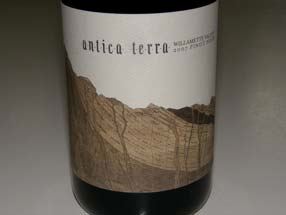 2007 Antica Terra Willamette Valley Pinot Noir 13.5% alc., 1,270 cases, $46. Released April 1 2009.Packaged in a distinctive tall-necked bottle. 53% Antica Terra Vineyard, 28% Shea Vineyard, 9% Cherry Grove Vineyard, 9% Croft Vineyard. 91% de-stemmed without crushing. Fermented in small, open-top fermenters with manual punch downs. Into barrel using gravity flow with 27% press. Aged in 53% new French oak. Unfined and unfiltered. · Teasing aromas of berry tart and spiced raspberries with a hint of pine tree. Tasty dark berry, black cherry and plum with nuances of minerality, earthiness, seasoned oak, spice and musk, which come and go in the glass. There might be some pheromones in there as well as I could not turn away from the glass. This wine has plenty of richness to satisfy, but not in the über-rich mold of SQN. It is very clean and silky with imperceptible tannins and impeccable balance. This beauty will hold your interest and is a truly unique artisan Pinot Noir.
Pinot Briefs
 Pinot Noir New Zealand 2010 This semi annual four day celebration of New Zealand Pinot Noir is scheduled for February 1-4, 2010. The celebration will feature the largest ever tasting of aged New Zealand Pinot Noir from New Zealand’s best producers and a regional tasting of New Zealand Pinot Noir from the 2007 vintage. 100+ top New Zealand producers will participate along with world class speakers including Leslie Sbrocco, Nick Stock, Matthew Jukes, Simon Tam, Tim Atkin MW, and Evan Goldstein MS. A formal tasting will include a selection of Pinot Noirs created from a variety of viticultural practices to confirm, confuse or clarify their purpose. American winemaker, Ted Lemon, will be a part of this tasting. For more information and registration visit www.pinotnoir2010.co.nz and follow the event on Twitter at www.twitter.com/pinotnoir2010. 3rd Annual The Dundee Hills Wine Experience Join ¡Salud! and the Dundee Hills Winegrowers Association for this tasting event on Friday, August 28, 2009 from 6:00 PM to 10:00 PM. Over 20 Dundee Hills wineries will be pouring Pinot Noirs, Chardonnays and other varietals accompanied by hors d’oeuvres and music. Bid on unique wine country excursions and collectible wines to benefit ¡Salud! healthcare services for Oregon’s seasonal vineyard workers and their families. Held at the Lawrence Gallery in Portland’s Pearl District. Tickets are $50 (online), $65 (at the door) which includes a Riedel Oregon Pinot Noir glass. For tickets and information including a list of participating wineries, visit www.dundeehills.org.
 14th Annual Grape to Glass Weekend This event is organized and hosted by the Russian River Valley Winegrowers on August 14-16, 2009. Events include a Tour de Vine Bike Ride, a Winery Poker Run, Sip ‘N’ Cinema at MacMurray Ranch, Ballooning over the Valley, Kayak the Russian River, Behind the Wines Tours and Special Programs, Hog in the Fog Winegrower BBQ, Tasting Fest and Auction at Richard’s Grove & Saralee’s Vineyard, and the “Wings Over Wine Country” Air show. The full program is available online at www.rrvw.org.
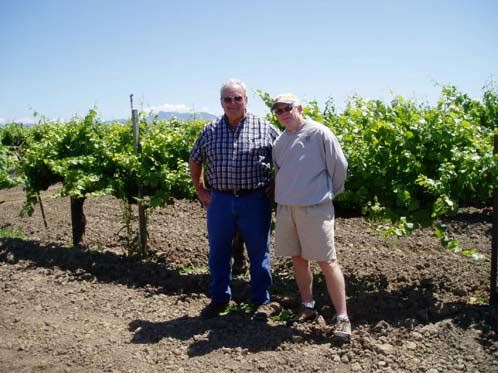 Joe Rochioli Honored Joe Rochioli is the 2009 recipient of the award for Lifetime Contribution to Sonoma County Agriculture presented at the Sonoma County Harvest Fair Awards Night Gala on September 26. Rochioli was one of the pioneering farmers who transformed Sonoma County from a backwater jug purveyor to a wine superpower. In the 1960s, he realized that his family’s tract of farmland along the Russian River on Westside Road had the perfect soil and climate to grow cool-climate Burgundian grapes. He was the first grower in the Russian River Valley to plant Sauvignon Blanc. The Sonoma County Harvest Fair will be held October 2-4 at the Sonoma County Fairgrounds in Santa Rosa. Cuvaison Celebrates Its 40th Anniversary For 40 years, Cuvaison has hosted visitors in their humble tasting room on the Silverado Trail. The historic Calistoga site has been redesigned with a contemporary approach to the classic tasting environment. The atmosphere is warm and welcoming, highlighted by an inviting tasting bar, retail boutique and tree-shaded picnic grounds. A second tasting center is now open in Carneros in the center of the winery’s 400-acre estate vineyards. The tasting room here has striking views of the vineyards and an intimate ambiance for enjoying tastings indoors or out, arranged by appointment. Cuvaison produces exemplary Napa Carneros Pinot Noirs and Chardonnays along with Napa Valley Cabernet Sauvignons. Visit the winery website for more about the 40th anniversary at www.cuvaison.com.
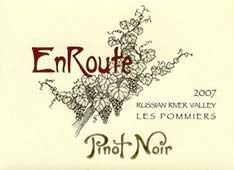 Far Niente Partners Launch EnRoute Winery EnRoute winery specializes in Russian River Valley Pinot Noir. The name, EnRoute, references the journey the owners took to produce Pinot Noir. The first release from the 2007 vintage is labeled “Les Pommiers,” which is named for the apple orchards that were once so prevalent in the Russian River Valley (1,275 cases, $50). The wine will be sourced from Amber Ridge Vineyard, Graton Vineyard and Manzana Vineyard, and vinified in Sebastopol by Andrew Delos, who was formerly an assistant winemaker at Pellegrini Family Vineyards. EnRoute Pinot Noir will be sold through an allocated mailing list. Visit the website at www.enroutewinery.com.
 19th Annual Family Winemakers of California Tasting 2009 Consumers (3:00 to 6:00) and trade (1:00 to 3:00) may attend on Sunday, August 23 (trade only on Monday, August 24) at Festival Pavilion, Fort Mason. This is the largest tasting of California wines in the world and features many of the state’s small, family owned wineries. The Southern California tasting will be held March 14 and 16, 2010. Alma Rosa Tops Greenopia Sustainability Rating Greenopia is an online service that rates and ranks green services and products. A rating of 25 major wine labels was recently released comparing sustainability. At the top of the list were Alma Rosa, Frog’s Leap and French Rabbit. Richard and Thekla Sanford, who attended the recent IPNC as representatives of their featured winery, Alma Rosa, have been committed to organic viticulture and sustainability for 25 years. All of Alma Rosa wines are bottled under screw cap. The study is available free at www.greenopia.com. Thomas Winery Pinot Noir Only the most devoted Pinot Noir cognoscenti know about John Thomas who produces about 400 cases of Pinot Noir from his vineyard in the Dundee Hills each year ($50). His wines are made in an elegant style and age very well. I have drank a number of vintages through the years. I sampled his 2006 Pinot Noir at the IPNC Salmon Bake and was floored. I thought it was the best wine among 30 or so I sampled that evening. He also has released a Thomas Winery Acme Wineworks NV Pinot Noir from declassified 2006 and 2007 fruit which is inexpensive ($18) and is not made every year. There is an Acme Wineworks NV Rosé as well ($13). Available at www.avalonwine.com.
 Et Fille Newest Releases Et Fille is a small boutique producer of Pinot Noir and Viognier working out of August Cellars in Newberg, Oregon. I am quite a fan of the wines. Two single vineyard 2007 Pinot Noirs were recently released: 2007 Blakeslee Vineyard Chehalem Mountains Pinot Noir (175 cases, $28) and 2007 Nicholas Vineyard Chehalem Mountains Pinot Noir (102 cases, $34). The Nicholas Vineyard is owned by Sheila and Nick Nicholas who produce wine under the Anam Cara label. I did not get a chance to taste these while I was in Oregon, but given the past Et Fille wines I have tried, I can bet these are winners. Visit www.etfillewines.com. Pinot Noir Most Planted in California in 2008 Jim Gordon, Editor, Wines & Vines, told a recent group of wine bloggers in a talk titled, “Trends Worth Blogging About,” that Allied Grape Growers reported that of the eight major varieties planted in 2008, 36% of the plantings were Pinot Noir, 22% Chardonnay, 16% Pinot Gris, 13% Cabernet Sauvignon, 5% Zinfandel, 4% Syrah, 2% Merlot, 2% Sauvignon Blanc. San Francisco Wine Association Growing Three new boutique wineries recently joined this alliance of urban wineries making the total number of members 20. SFWA members do not have fancy wineries or tasting rooms, but craft their wines in San Francisco using cutting-edge equipment. Many employ outstanding winemakers. The three newest additions are Bartz-Allen Winery, Kindred Wines and Wait Cellars. Food & Wine Pairings App for iPhone and BlackBerry Noted Canadian wine writer, Natalie MacLean, (Nats Decants) has released her Nats Decants Drinks Matcher mobile application for iPhone, iPod Touch and BlackBerry. The App contains 380,000 wine and food pairings that can be easily accessed while in a wine store or a restaurant. The Nat Decants Drinks Matcher is $2.99 and can be downloaded in two minutes from the online stores for iPhone or BlackBerry. To view a video demo on how the App works, visit: www.nataliemaclean.com/mobilematch. Daily matching tips are accessible at www.twitter.com/Natalie MacLean.
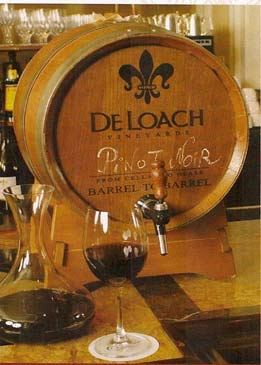 DeLoach Vineyards Barrel-To-Barrel Wine Service DeLoach Vineyards in the Russian River Valley is offering a new wine-by-the-glass service intended for hotels and restaurants. DeLoach partnered with The Fairmont Hotel in San Francisco to produce a 10-liter barrel of Pinot Noir from which wine can be dispensed at the hotel providing a tasting experience for the consumer that is close to an actual barrel tasting in a cellar. Additionally, the offering provides a low by-the-glass carbon footprint and reduces waste. The interior of the barrel contains an ecobag that guarantees the wine stays fresh with no risk of tainted corks. The bags protect the wine for a minimum of six to eight weeks after opening. The cost of the 10-liter barrel approximates a typical 9-liter case, offering an extra liter of wine for the same cost. Each eco-bag holds the equivalent of 67 glasses at a five-ounce pour, or more than 13 standard bottles of wine. DeLoach plans to offer a range of Pinot Noirs, from its California appellation to Sonoma Coast and Russian River Valley appellation wines to a highly allocated selection of single vineyard wines. Ampelos Vineyard Certified Sustainable, Organic and Biodynamic Ampelos is the first vineyard in Santa Barbara County and one of the first in the United States to receive certification of Sustainability in Practice (SIP), Organic, and Biodynamic practices from each governing body: Central Coast Vineyard Team (SIP), Stellar (USDA organics), and Demeter (biodynamic). Ampelos Cellars is a small family owned winery producing small quantities of red and white wines. The Ampelos Vineyard is located in the Sta. Rita Hills and the winery is in Lompoc. The website is www.ampeloscellars.com.
 J Vineyards & Winery Adds Three Estate Pinot Noir and Chardonnay Vineyards J now farms 257 acres of vineyards throughout the Russian River Valley. Ten in all, the vineyards encompass the entire Russian River Valley from north to south. 9 rootstocks, 14 clones of Pinot Noir, 10 clones of Chardonnay and 3 clones of Pinot Gris supply diversity and give winemaker George Bursick a range of flavor profiles to work with. The three new vineyards are named Sally Ann’s Vineyard (Named after owner Judy Jordan’s mother, Sally Ann Jordan), Bow Tie Vineyard (Named after Judy’s grandfather who would not be caught out for dinner without his bow tie), and Dotty Stan Vineyard (named after two life long friends who changed Judy’s life). The website is www.jwine.com. New Mockumentary Film - ‘Corked!’ This is a new film that makes fun of the pretentious side of the wine world and may see distribution in California soon. It is a low-budget spoof which details the happenings at four wineries and follows the people who work at each winery. The Los Angeles Times compared it to ‘Bottle Shock.’ The writers and directors of the film, Ross Clendenen (no relation to Jim Clendenen) and Paul Hawley (whose family owns one of the wineries in the film) have both worked in wineries. The film was screened at the Sonoma Film Festival in June. Read the favorable review of the film posted in May, 2009: http://www.hollywoodreporter.com/hr/film-reviews/corked-film-review-1003976047.story Movie Planned on the French Paradox Actress Hiliary Swank has bought the film rights to the best-selling book that reveals the secrets of the French Paradox, French Women Don’t Get Fat. The author, Mireille Guilliano, was a former executive at the Champagne house Veuve Clicquot. The French Paradox was first brought to this country’s attention by Morely Safer in a 1991 60 Minutes broadcast that revealed that the French lifestyle, which includes regular consumption of wine with meals, leads to a lower incidence of heart disease and a longer life span.
Purple Wine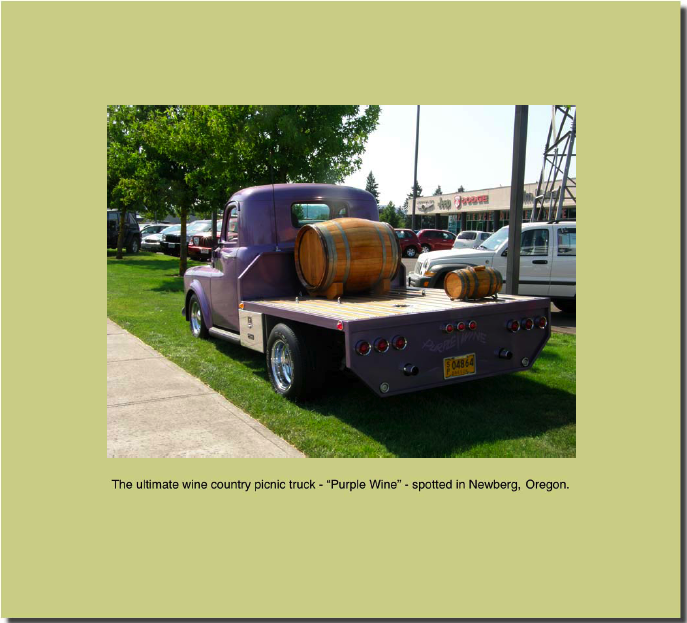 |